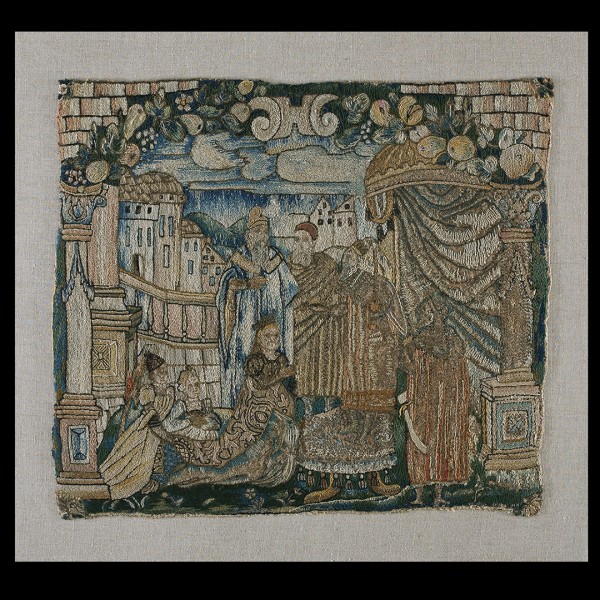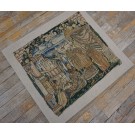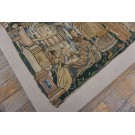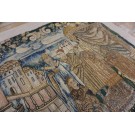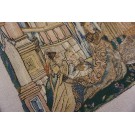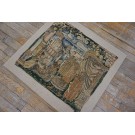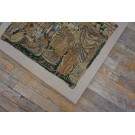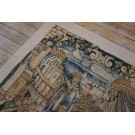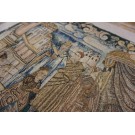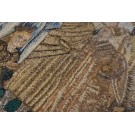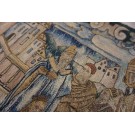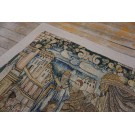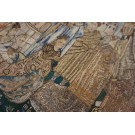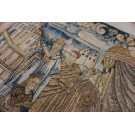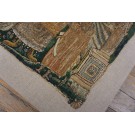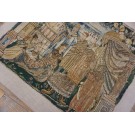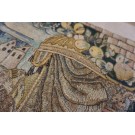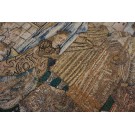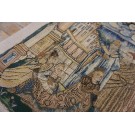Netherlandish Biblical Scene Silk Embroidery
Silk Embroidery – Biblical Scene
Wool, Silk & Silver Threads on Linen Foundation
Netherlandish
Mid-16th Century
The scene approximates in miniature a small tapestry with several august male figures clustered around a kneeling noblewoman and her two attendants.
Without text the scene is not definitively identifiable, but it could be Esther & Ahasuerus or Bilqis; Queen of Sheba Before Solomon.
The male figures are dressed in quasi-antique attire while the women are in 16th century clothing.
The kneeling woman wears an overdress dress of Italian silk with a large palmette and leaf design.
She wears a crown and all the other figures wear hats. Columns with acanthus Corinthian capitals and stacked bases are both set on inset tabula
ansata structures.
Each column has a draped pseudo-textile swag part way up. At the right is a modeled drapery with a hemispherical and gadrooned top, probably some sort of tent.
All the figures are posed in and before an urban townscape, with a balustrade and domed buildings. behind them. Other structures are set further in the background and above is streaky sky The sky transition between blue and ecru is managed by comb-like teeth, just as tapestries do. In the top corners are fragments of rough brickwork.
Connecting the two sides is a stonework lintel. At the top center is an illusionistic scrollwork, and it binds two swags laden with grapes, apples, pears and other fruit.
The colors include: chocolate brown, straw, medium blue, cream, and shades of green .
The stitch is varied and the original work includes couching. Restorations have been carried out in wool, in long stitch, among others.
The ground material is linen, and uniformly Z-2. The silk has been executed in Z-2 and the wool in Z-2 as well. The structure of the silk embroidery is difficult to discern.
As to the dating, the use of fruit-filled swags is a Renaissance trope and appears on later tapestries, well into the 16th century.
The scrolling motif at the top of the textile is found in Netherlandish art and architecture, from the 16th century on ward.
Dutch scrolling gable architecture relies on this element. The swag and the scroll are not seen in northern art before the 16th century.
Pieter Coecke van Elst was among the first to employ them. We find closely similar fruit, flower and foliage swags on 17th century tapestries after Rubens, i.e., in numerous panels and sets of the Mythological Hunt series; the Boar Hunt for example.
Since nothing is earlier than its newest original part, we can confidently assert that this
embroidery is from the 16th century at least.
The historicizing attire does not militate against this conclusion as artists employed earlier costumes to indicate that the action took place long ago.
It was probably copied from a tapestry or from an illustration in a Bible of the period.
The condition is fair, with irregular edges, somewhat bald small areas, and several campaigns of restoration.
The original function is not clear. Originally larger, it was always too fragile to serve as an upholstery panel for chair seat or back. Most period more-or-less Dutch upholstery panels are usually executed in wool tapestry weave or in wool needlepoint, with a few silk details at most. The colours are softened with age.
Wool, Silk & Silver Threads on Linen Foundation
Netherlandish
Mid-16th Century
The scene approximates in miniature a small tapestry with several august male figures clustered around a kneeling noblewoman and her two attendants.
Without text the scene is not definitively identifiable, but it could be Esther & Ahasuerus or Bilqis; Queen of Sheba Before Solomon.
The male figures are dressed in quasi-antique attire while the women are in 16th century clothing.
The kneeling woman wears an overdress dress of Italian silk with a large palmette and leaf design.
She wears a crown and all the other figures wear hats. Columns with acanthus Corinthian capitals and stacked bases are both set on inset tabula
ansata structures.
Each column has a draped pseudo-textile swag part way up. At the right is a modeled drapery with a hemispherical and gadrooned top, probably some sort of tent.
All the figures are posed in and before an urban townscape, with a balustrade and domed buildings. behind them. Other structures are set further in the background and above is streaky sky The sky transition between blue and ecru is managed by comb-like teeth, just as tapestries do. In the top corners are fragments of rough brickwork.
Connecting the two sides is a stonework lintel. At the top center is an illusionistic scrollwork, and it binds two swags laden with grapes, apples, pears and other fruit.
The colors include: chocolate brown, straw, medium blue, cream, and shades of green .
The stitch is varied and the original work includes couching. Restorations have been carried out in wool, in long stitch, among others.
The ground material is linen, and uniformly Z-2. The silk has been executed in Z-2 and the wool in Z-2 as well. The structure of the silk embroidery is difficult to discern.
As to the dating, the use of fruit-filled swags is a Renaissance trope and appears on later tapestries, well into the 16th century.
The scrolling motif at the top of the textile is found in Netherlandish art and architecture, from the 16th century on ward.
Dutch scrolling gable architecture relies on this element. The swag and the scroll are not seen in northern art before the 16th century.
Pieter Coecke van Elst was among the first to employ them. We find closely similar fruit, flower and foliage swags on 17th century tapestries after Rubens, i.e., in numerous panels and sets of the Mythological Hunt series; the Boar Hunt for example.
Since nothing is earlier than its newest original part, we can confidently assert that this
embroidery is from the 16th century at least.
The historicizing attire does not militate against this conclusion as artists employed earlier costumes to indicate that the action took place long ago.
It was probably copied from a tapestry or from an illustration in a Bible of the period.
The condition is fair, with irregular edges, somewhat bald small areas, and several campaigns of restoration.
The original function is not clear. Originally larger, it was always too fragile to serve as an upholstery panel for chair seat or back. Most period more-or-less Dutch upholstery panels are usually executed in wool tapestry weave or in wool needlepoint, with a few silk details at most. The colours are softened with age.
| Stock ID: | #24362 |
| General Rug Type: | European |
| Specific Rug Type: | Tapestry |
| Circa: | 1550 |
| Ground Color: | Multi |
| Origin: | The Netherlands |
| Width: | 3' 9" ( 114 cm ) |
| Length: | 4' 6" ( 137 cm ) |
| Tearsheet Download |
